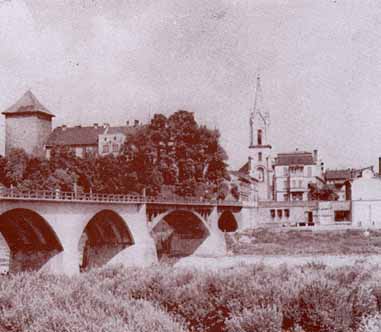The Town of Auschwitz
 Town of Auschwitz looks
just as it did in this 1940 photo
Town of Auschwitz looks
just as it did in this 1940 photo
If asked to name a city or town in Poland,
most Americans could probably come up with the name Warsaw, the
capital and largest city. A few educated people might be able
to dredge up the name Krakow, the city that boasts one of the
oldest universities in the world. But the town name that would
immediately leap into the minds of most Americans would be Auschwitz,
although many people would not know that it is now called by
its Polish name, Oswiecim.
The town of Oswiecim, by itself, is quite
unremarkable. It is a factory town in the province of Upper Silesia
in an industrial area now called the Black Triangle because of
the air pollution problem. Driving through the town, you can
still see the gray factory buildings where the prisoners at the
Auschwitz concentration camp worked as forced laborers for the
I.G. Farben company over sixty years ago. The buildings which
once housed the factories at the former Auschwitz III camp, called
Monowitz by the Germans, are still there and some are still in
use.
The actual town of Oswiecim has virtually
nothing to recommend it to a typical tourist. As far as I could
see, there were only four hotels in the town in October 2005,
and no night life. There is a 17th century Catholic church at
the entrance to the Old Town, and the ubiquitous Duke's castle
on a bluff overlooking the Sola, a small stream that passes for
a river, but nothing is left of the original castle except a
small tower, now obscured by trees, which is not at all impressive.
Like the church, the castle tower will never make it into most
tourist guidebooks.
The town is completely devoid of charm.
No famous artists come here to paint. There is no house that
has been preserved as the birthplace of a famous person, nor
any important historical buildings. The town square is surrounded
by very ordinary looking buildings, constructed durng the last
200 years, and has only one building of interest: the District
Court. An ugly looking modern store built right in the middle
of the town square has totally ruined any character that Auschwitz
might have had. There were no thatched-roof cottages, no log
houses, nor half-timbered buildings that I saw on my trip there
in October 2005. The town now has a population of 50,000 and
it appears that most of the residents live in high-rise apartments
built during the Communist era.
There are many ordinary towns in Poland
and it is only because Auschwitz has become the most famous town
in the history of the Holocaust that anyone today marvels at
how ordinary it is. Yet a suburb of this ordinary town is included
in every package tour of Poland or Eastern Europe: an afternoon
of horror at the Auschwitz concentration camp, sandwiched in
between stops to see the famous salt mine and the Black Madonna,
the other main tourist attractions of Poland.
Huge buses now rumble past the town,
carrying Polish students to the suburb of Zazole on a trip to
see the concentration camp as soon as they have reached the age
of 14 and are old enough be allowed to enter it. Brightly painted
buses from Krakow, Prague and Munich arrive daily, bringing swarms
of tourists to visit the former death camp, but they don't cross
the Sola river and enter the town. Seventeen-year-old students
from around the world make bi-annual pilgrimages to this place,
parading with flags of Israel in the March of the Living.
Through this town have passed the leaders
of virtually every country in the world, including American President
George W. Bush, Vice President Dick Cheney and French President
Jacques Chirac, bearing huge funeral wreaths to lay at the famous
black wall where Polish political prisoners were shot. With more
than a million annual visitors, there are now more people walking
the streets of the Auschwitz concentration camp than there ever
were when it was in operation.
|